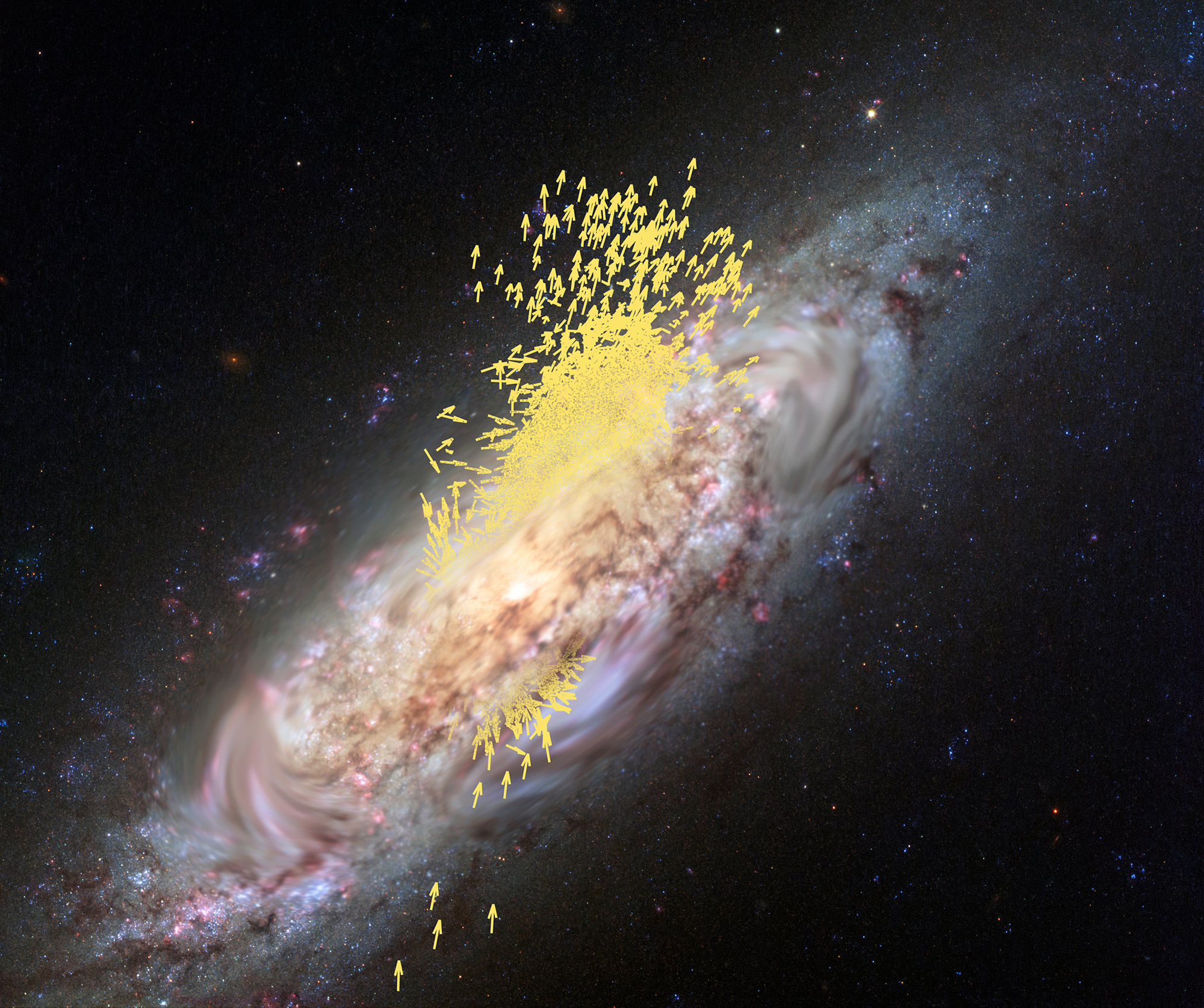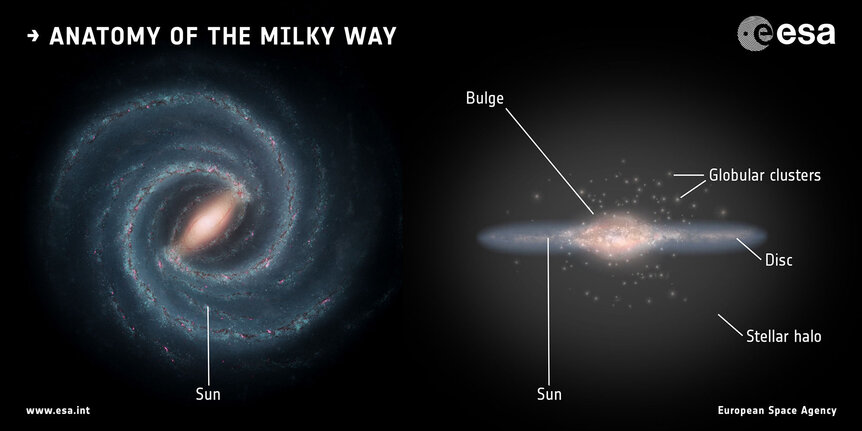Create a free profile to get unlimited access to exclusive videos, sweepstakes, and more!
The Milky Way ate another galaxy, and we can still see the undigested bits

Our Milky Way galaxy grows by eating other galaxies.
We know this for many reasons. For one, we can see other galaxies colliding and merging all over the sky. For another, we can track stars on our galaxy that were once part of another galaxy, but were absorbed into our own. These are usually relatively recent events involving a much smaller galaxy.
But a new result changes that. By mapping huge numbers of stars in the galaxy, astronomers have found compelling evidence that the Milky Way ate a galaxy that was, at the time, about a quarter its size. And that time was a staggering ten billion years ago.
Yeah, this is very cool.
The stars in question were mapped by Gaia, a European Space Agency satellite. It is in the process of mapping the positions, motions, colors, and most importantly the distances of well over a billion stars. Yes, a billion.
Gaia has provided nothing short of a revolution in astronomy. How can mapping stars be so important? In some cases it can solve long-standing puzzles that have irritated astronomers for decades. In others it can reveal hidden denizens of the Milky Way. It can resolve uncertainties in distances to critical stars called Cepheids — like Polaris, the North Star — that are the bottom rung of the distance ladder, where each rung is a single step, but by the time you get to the top you’re measuring distances on a cosmic scale.
And in this new case, it reveals the remnants of a long-dead galaxy, one used as sustenance for our own.
What Gaia found was a vast stream of stars, 30,000 strong, that travel along similar orbits around the center of the Galaxy: highly elongated, tipped to the plane of the galaxy’s disk, and weirdly in a direction backward relative to other stars. This structure is so big that we’re actually inside it — literally, it surrounds the Sun in all directions — and can be seen stretching nearly across the entire sky. This stream is the remnant of the now-eaten galaxy.
The astronomers even gave that galaxy a name: Gaia-Enceladus, after the observatory that found it, of course, and the name of one of the Giants, which in Greek mythology were created when the Titan Cronus castrated his father Uranus and the blood was “received” (um, yeah) by the Earth-goddess Gaia. Yeah, I know, but Greek mythology is as gruesome as it is just plain weird. Anyway, the myth is a rough fit to what happened to the galaxy, so why not. My only complaint is that we already have a moon of Saturn named Enceladus, but given the relative scales they’re not likely to be confused with each other.
To understand why this is so important, picture the Milky Way: an enormous flat disk of stars, gas, and dust, with a central hub (a flattened bulge of stars in the very center) and all surrounded by a vast roughly spherical halo of stars as well.
If a smaller galaxy approaches us, our stronger gravity will start to stretch and eventually tear apart the smaller galaxy (because gravity gets weaker with distance, so the front of the smaller galaxy is pulled harder by the Milky Way than the back; we call this effect tidal stretching). It may survive the first pass, but if it’s bound to us — that is, if it isn’t moving rapidly enough to escape — then it will orbit us, getting ripped apart over time.
Sometime later all that’s left is an elliptical stream of stars, perhaps in a complete loop around the Milky Way. If the incoming galaxy were approaching at an angle to the disk, then so too will be the stream, and could even go around the center of the Milky Way in the opposite direction to the stars in the disk.
And that’s just what the observations found. Now, Gaia only found about 30,000 stars like this, but it can’t see all the way across the Milky Way, or get distances from stars that are too far away, so we’re only seeing a section of this stream. But it’s still pretty convincing; if all the orbital characteristics weren’t enough, the stars also are chemically distinct from stars in our Milky Way, with a lot less iron in them than you see in “native” Milky Way stars. Also, using various indicators, the stars all appear to be roughly the same age, about 10 – 13 billion years old.
All of these are what you expect from a merger. Using the physics of how mergers behave, the astronomers created a simulation of what the collision and merger looked like:
The best fit to what’s seen is a merger with a flattened galaxy about ¼ the size of the Milky Way at the time (our galaxy is much larger now after lots more cannibalizing events) getting torn apart and eaten about 10 billion years ago. It came in at a 30-60° angle, and after all these eons what’s left of it is this stream of stars.
And globular clusters, too: ancient collections of hundreds of thousands of stars packed into a small volume, held together by their mutual gravity. More than 150 globulars orbit the Milky Way, and over a dozen of them were also found on a similar trajectory to the star stream… including Omega Centauri. I actually gasped when I saw that in the research paper! Omega Cen is the largest globular cluster in the Milky Way, containing perhaps ten million stars. It’s easily visible to the naked eye from southern latitudes, and is so big it’s been conjectured to have once been the core of a long-dead galaxy that was eaten by the Milky Way.
Whoa. That’s a very big deal indeed. I’ve seen Omega Cen with my own eyes, and now I have to re-evaluate that observation in this light. It’s now significantly cooler.
As a bonus, this merger explains some other features seen in the Milky Way, too. For example, the disk of the Milky Way itself can be split into two components, the thin disk and the thick disk — which is descriptive enough. The reason part of the disk is thicker hasn’t been entirely clear, but a collision of this magnitude 10 billion years ago would explain it; the energy added by the collision puffed up part of the original disk, creating a thicker component. There’s also an inner and outer halo, too, and the inner halo would be other debris from this collision that’s no longer in the star stream. It’s nice when a single simple hypothesis explains a lot of different observations.
What’s funny to me about all this is that as incredible as it is — the Milky Way ate a big galaxy billions of years ago! — it’s actually been more or less the accepted idea for some time; there’s evidence of other stellar streams in the Milky Way from previous mergers with dwarf (smaller) galaxies. We just hadn’t seen evidence of this one until now. What strikes me the most about it is how long ago it happened. Ten billion years is a long, long time, and the Milky Way was pretty young back then. To still see evidence, so plainly and obviously once we had the tools, after so many eons is just amazing.
And that is why Gaia is a revolution in the making. There’s so much to see in our galaxy, and we just didn’t have the means to see it.
Now we do.






























